Page 831 of 4133
27 At a glance
Center console
�Center console
Upper part
Item
Page
1
Air vents, automatic
climate control
142
2
MCS, see separate
operating instructions
3
Automatic climate control
134
Rear window defroster
switch
133
4
Seat heater switch*,
passenger side
98
5
Rear quarter window
switch*, right
146
6
ESP control switch
80
Item
Page
7
Rear window
wiper / washer switch
51
8
Rear quarter window
switch*, left
146
9
Seat heater switch*,
driver’s side
98
a
Front and rear fog lamp
switch
111
b
Indicator lamp for antitheft
alarm system
83
c
Transmission control
switch, LOW RANGE mode
125
Page 836 of 4133
32 Getting startedUnlocking
�The “Getting started” section provides an
overview of the vehicle’s most basic func-
tions. First-time Mercedes-Benz owners
should pay special attention to the infor-
mation given here.
If you are already familiar with the basic
functions described here, the “Controls in
detail” section will provide you with further
information. The corresponding page refer-
ences are located at the end of each seg-
ment.
Unlocking
Remote control with folding keyRemote control with folding key1ÂPanic button (
�page 75)
2ŒUnlock button
3‹Lock button
4Release button for key
5ŠUnlock button for liftgate
�
Press unlock buttonΠon the re-
mote control.
All turn signal lamps flash once. The
locking knobs in the doors move up.
�
Press release button4 on the remote
control.
The key folds out.
�
Get in the vehicle and insert the key in
the steering lock (
�page 33).
More information can be found in the
“Controls in detail” section (
�page 88).
Page 844 of 4133
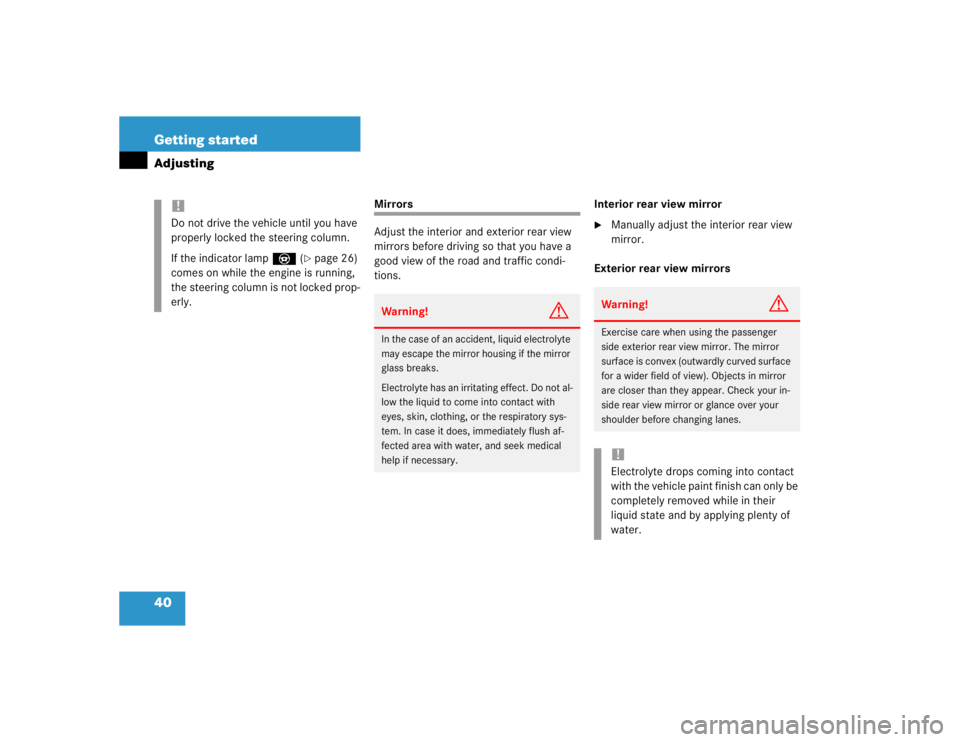
40 Getting startedAdjusting
Mirrors
Adjust the interior and exterior rear view
mirrors before driving so that you have a
good view of the road and traffic condi-
tions.Interior rear view mirror
�
Manually adjust the interior rear view
mirror.
Exterior rear view mirrors
!Do not drive the vehicle until you have
properly locked the steering column.
If the indicator lamp_ (
�page 26)
comes on while the engine is running,
the steering column is not locked prop-
erly.
Warning!
G
In the case of an accident, liquid electrolyte
may escape the mirror housing if the mirror
glass breaks.
Electrolyte has an irritating effect. Do not al-
low the liquid to come into contact with
eyes, skin, clothing, or the respiratory sys-
tem. In case it does, immediately flush af-
fected area with water, and seek medical
help if necessary.
Warning!
G
Exercise care when using the passenger
side exterior rear view mirror. The mirror
surface is convex (outwardly curved surface
for a wider field of view). Objects in mirror
are closer than they appear. Check your in-
side rear view mirror or glance over your
shoulder before changing lanes.!Electrolyte drops coming into contact
with the vehicle paint finish can only be
completely removed while in their
liquid state and by applying plenty of
water.
Page 859 of 4133
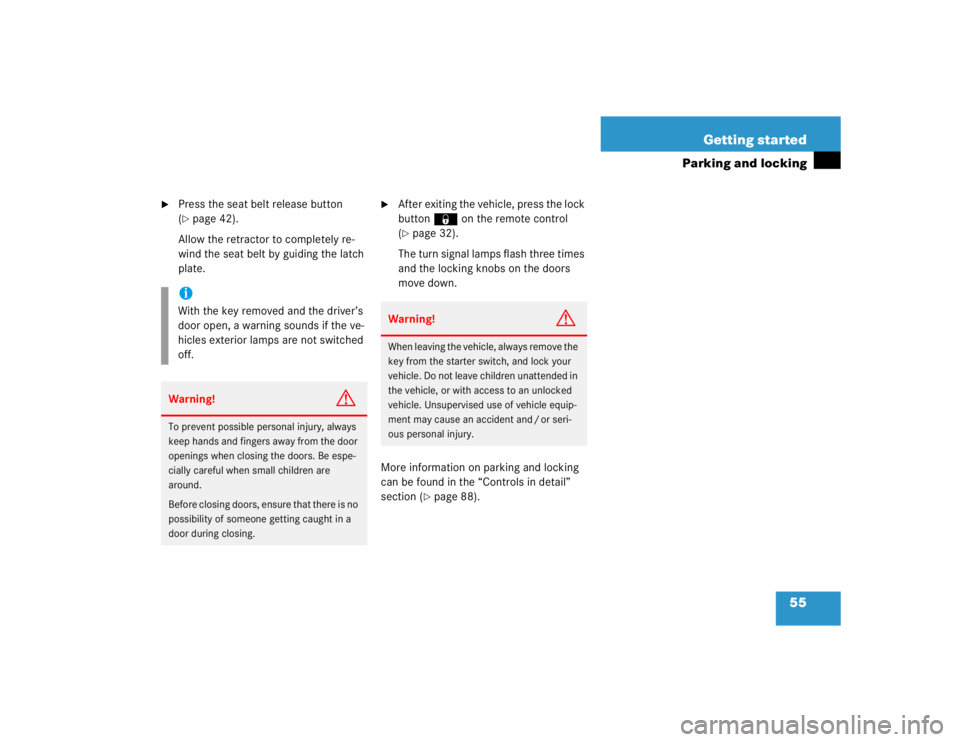
55 Getting started
Parking and locking
�
Press the seat belt release button
(�page 42).
Allow the retractor to completely re-
wind the seat belt by guiding the latch
plate.
�
After exiting the vehicle, press the lock
button‹ on the remote control
(�page 32).
The turn signal lamps flash three times
and the locking knobs on the doors
move down.
More information on parking and locking
can be found in the “Controls in detail”
section (�page 88).
iWith the key removed and the driver’s
door open, a warning sounds if the ve-
hicles exterior lamps are not switched
off.Warning!
G
To prevent possible personal injury, always
keep hands and fingers away from the door
openings when closing the doors. Be espe-
cially careful when small children are
around.
Before closing doors, ensure that there is no
possibility of someone getting caught in a
door during closing.
Warning!
G
When leaving the vehicle, always remove the
key from the starter switch, and lock your
vehicle. Do not leave children unattended in
the vehicle, or with access to an unlocked
vehicle. Unsupervised use of vehicle equip-
ment may cause an accident and / or seri-
ous personal injury.
Page 864 of 4133
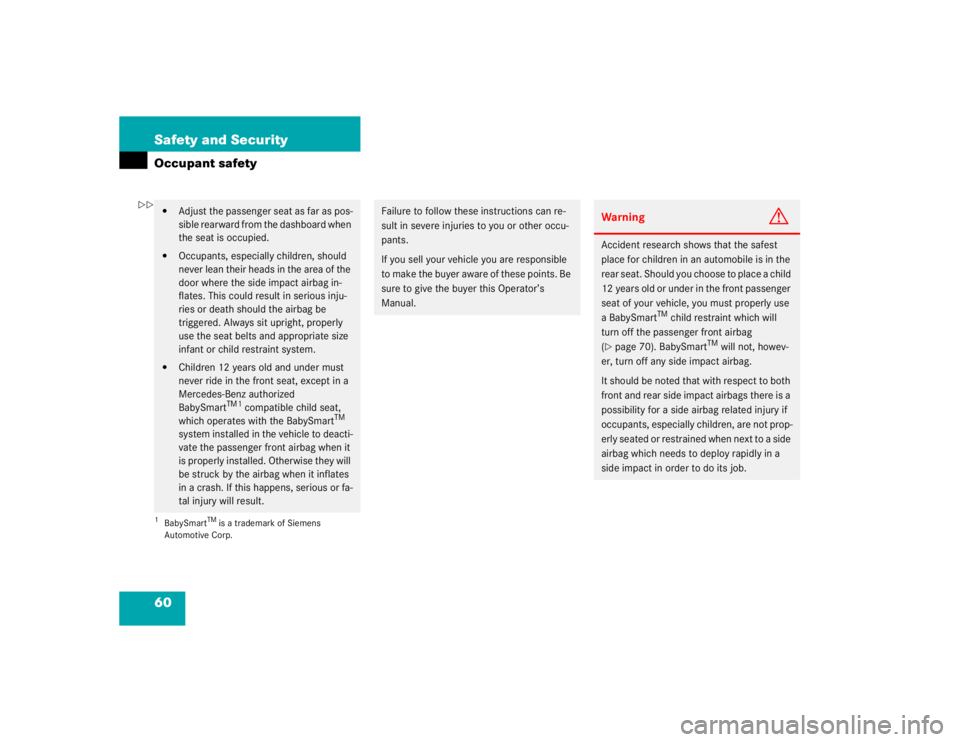
60 Safety and SecurityOccupant safety�
Adjust the passenger seat as far as pos-
sible rearward from the dashboard when
the seat is occupied.
�
Occupants, especially children, should
never lean their heads in the area of the
door where the side impact airbag in-
flates. This could result in serious inju-
ries or death should the airbag be
triggered. Always sit upright, properly
use the seat belts and appropriate size
infant or child restraint system.
�
Children 12 years old and under must
never ride in the front seat, except in a
Mercedes-Benz authorized
BabySmart
TM1
compatible child seat,
which operates with the BabySmart
TM
system installed in the vehicle to deacti-
vate the passenger front airbag when it
is properly installed. Otherwise they will
be struck by the airbag when it inflates
in a crash. If this happens, serious or fa-
tal injury will result.
1BabySmart
TMis a trademark of Siemens
Automotive Corp.
Failure to follow these instructions can re-
sult in severe injuries to you or other occu-
pants.
If you sell your vehicle you are responsible
to make the buyer aware of these points. Be
sure to give the buyer this Operator’s
Manual.
Warning
G
Accident research shows that the safest
place for children in an automobile is in the
rear seat. Should you choose to place a child
12 years old or under in the front passenger
seat of your vehicle, you must properly use
a BabySmart
TM child restraint which will
turn off the passenger front airbag
(
�page 70). BabySmart
TM will not, howev-
er, turn off any side impact airbag.
It should be noted that with respect to both
front and rear side impact airbags there is a
possibility for a side airbag related injury if
occupants, especially children, are not prop-
erly seated or restrained when next to a side
airbag which needs to deploy rapidly in a
side impact in order to do its job.
��
Page 865 of 4133
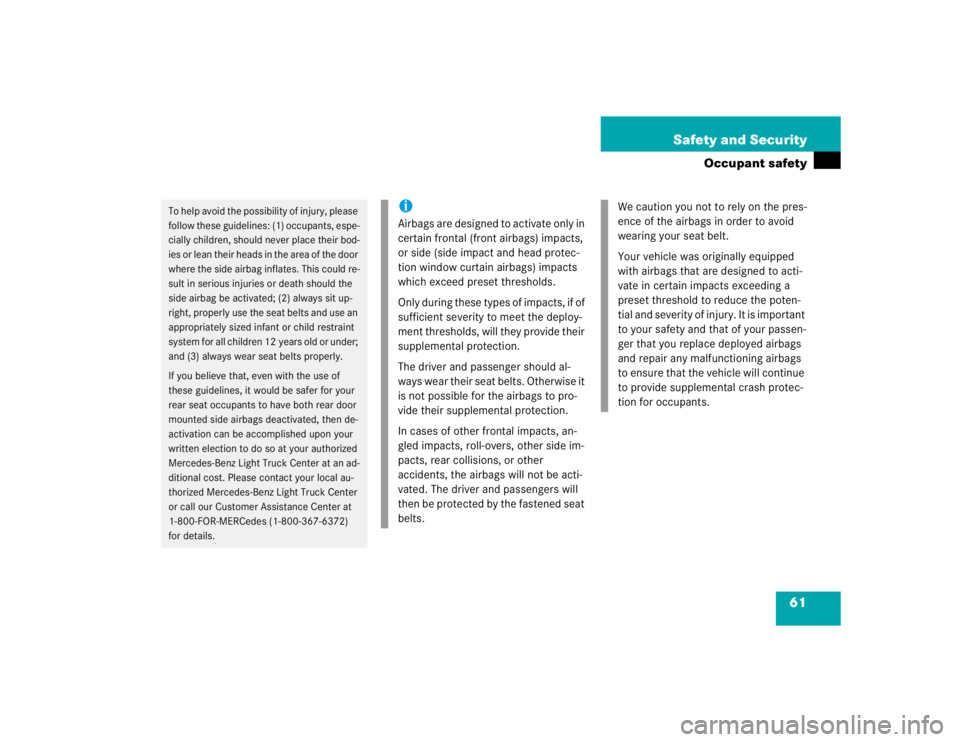
61 Safety and Security
Occupant safety
To help avoid the possibility of injury, please
follow these guidelines: (1) occupants, espe-
cially children, should never place their bod-
ies or lean their heads in the area of the door
where the side airbag inflates. This could re-
sult in serious injuries or death should the
side airbag be activated; (2) always sit up-
right, properly use the seat belts and use an
appropriately sized infant or child restraint
system for all children 12 years old or under;
and (3) always wear seat belts properly.
If you believe that, even with the use of
these guidelines, it would be safer for your
rear seat occupants to have both rear door
mounted side airbags deactivated, then de-
activation can be accomplished upon your
written election to do so at your authorized
Mercedes-Benz Light Truck Center at an ad-
ditional cost. Please contact your local au-
thorized Mercedes-Benz Light Truck Center
or call our Customer Assistance Center at
1-800-FOR-MERCedes (1-800-367-6372)
for details.
iAirbags are designed to activate only in
certain frontal (front airbags) impacts,
or side (side impact and head protec-
tion window curtain airbags) impacts
which exceed preset thresholds.
Only during these types of impacts, if of
sufficient severity to meet the deploy-
ment thresholds, will they provide their
supplemental protection.
The driver and passenger should al-
ways wear their seat belts. Otherwise it
is not possible for the airbags to pro-
vide their supplemental protection.
In cases of other frontal impacts, an-
gled impacts, roll-overs, other side im-
pacts, rear collisions, or other
accidents, the airbags will not be acti-
vated. The driver and passengers will
then be protected by the fastened seat
belts.
We caution you not to rely on the pres-
ence of the airbags in order to avoid
wearing your seat belt.
Your vehicle was originally equipped
with airbags that are designed to acti-
vate in certain impacts exceeding a
preset threshold to reduce the poten-
tial and severity of injury. It is important
to your safety and that of your passen-
ger that you replace deployed airbags
and repair any malfunctioning airbags
to ensure that the vehicle will continue
to provide supplemental crash protec-
tion for occupants.
Page 880 of 4133

76 Safety and SecurityDriving and safety systems
�Driving and safety systemsIn this section you will find information on
the following driving safety systems:�
ABS (A
ntilock B
rake S
ystem)
�
BAS (B
rake A
ssist S
ystem)
�
4-ETS (E
lectronic T
raction S
ystem)
�
EBP (E
lectronic B
rake P
roportioning)
�
ESP (E
lectronic S
tability P
rogram)
ABS
The Antilock Brake System (ABS) regulates
the brake pressure so that the wheels do
not lock during braking. This allows you to
maintain the ability to steer your vehicle.
The ABS is functional above a speed of ap-
proximately 5 mph (8 km / h) independent
of road surface conditions.
On slippery road surfaces, the ABS will re-
spond even with light brake pressure.
The -indicator lamp in the instrument
cluster (
�page 25) comes on when you
turn the key to position2. It goes out when
the engine is running.
iIn winter operation, the maximum ef-
fectiveness of the ABS, the BAS, the
ESP, the EBP, and the 4-ETS is only
achieved with winter tires (M + S tires)
or snow chains as required.
Warning!
G
The following factors increase the risk of
accidents:�
Excessive speed, especially in turns
�
Wet and slippery road surfaces
�
Following another vehicle too closely
ABS, BAS, ESP and 4-ETS cannot reduce this
risk.
Always adjust your driving style to the pre-
vailing road and weather conditions.
Warning!
G
Do not pump the brake pedal. Use firm,
steady brake pedal pressure instead. Pump-
ing the brake pedal defeats the purpose of
the ABS and significantly reduces braking
effectiveness.
Page 881 of 4133
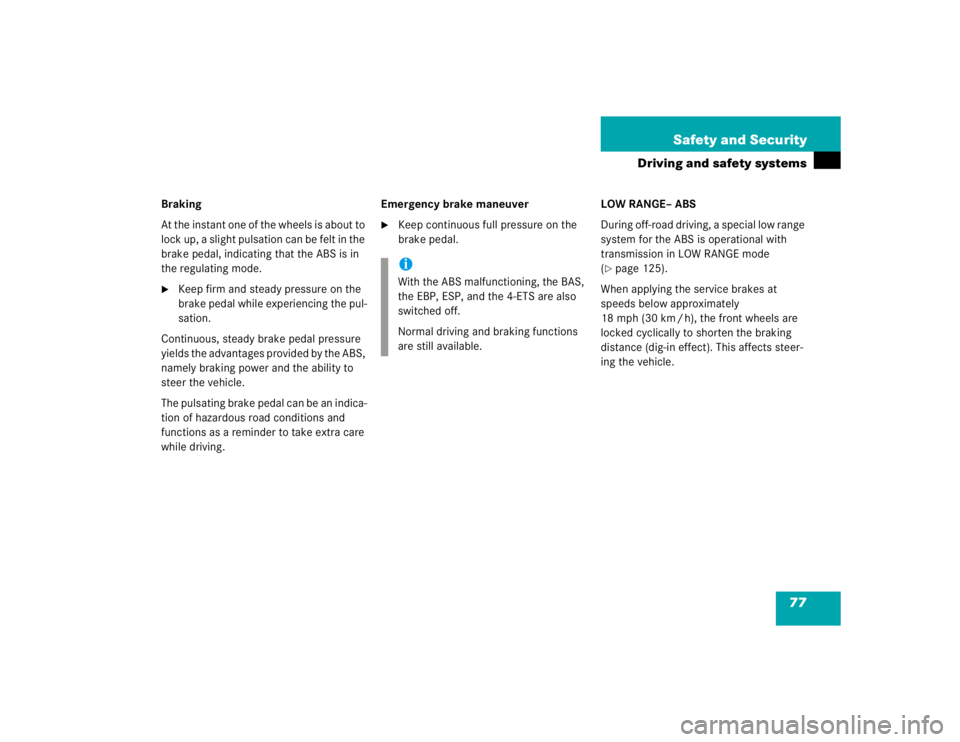
77 Safety and Security
Driving and safety systems
Braking
At the instant one of the wheels is about to
lock up, a slight pulsation can be felt in the
brake pedal, indicating that the ABS is in
the regulating mode.�
Keep firm and steady pressure on the
brake pedal while experiencing the pul-
sation.
Continuous, steady brake pedal pressure
yields the advantages provided by the ABS,
namely braking power and the ability to
steer the vehicle.
The pulsating brake pedal can be an indica-
tion of hazardous road conditions and
functions as a reminder to take extra care
while driving.Emergency brake maneuver
�
Keep continuous full pressure on the
brake pedal.LOW RANGE– ABS
During off-road driving, a special low range
system for the ABS is operational with
transmission in LOW RANGE mode
(
�page 125).
When applying the service brakes at
speeds below approximately
18 mph (30 km / h), the front wheels are
locked cyclically to shorten the braking
distance (dig-in effect). This affects steer-
ing the vehicle.
iWith the ABS malfunctioning, the BAS,
the EBP, ESP, and the 4-ETS are also
switched off.
Normal driving and braking functions
are still available.